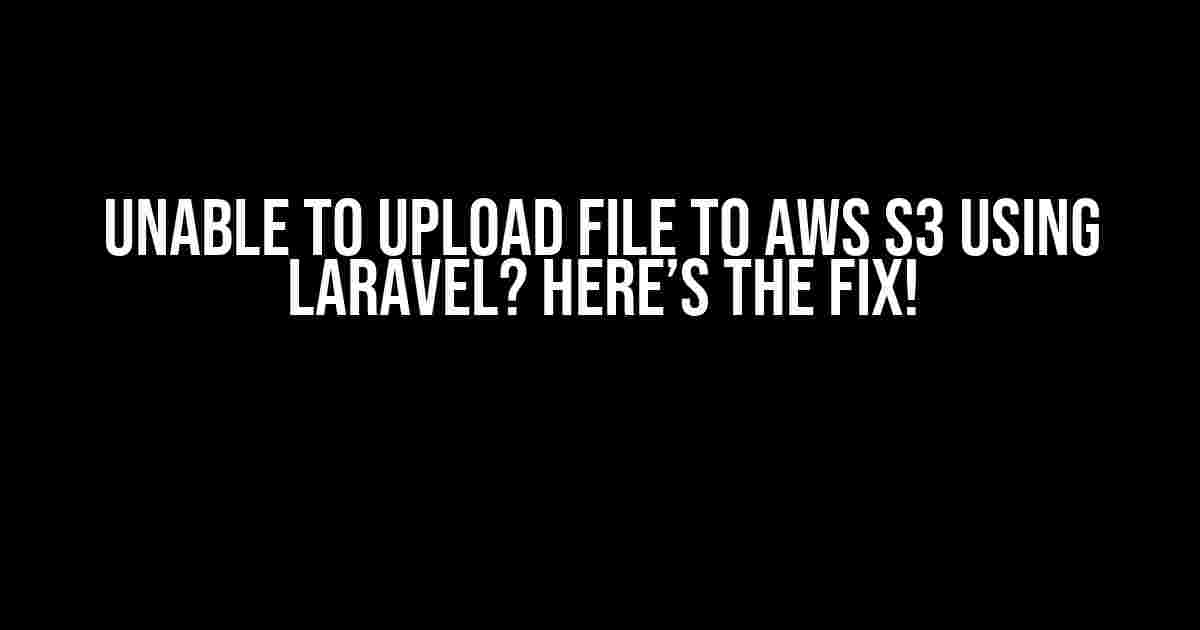Here is the article:
If you’re experiencing issues uploading files to AWS S3 using Laravel, you’re not alone. This is a common problem that can be frustrating and time-consuming to resolve. Fortunately, we’ve got you covered. In this article, we’ll walk you through the common causes and solutions to get you back up and running in no time.
Common Causes of Upload Failures
Before we dive into the solutions, let’s first understand the common causes of upload failures to AWS S3 using Laravel:
- Incorrect Bucket Permissions
- Invalid AWS Credentials
- Mismatched Region Configuration
- File Size Exceeds Limit
- Missing Required Dependencies
Solution 1: Verify Bucket Permissions
Ensure that the IAM user or role has the necessary permissions to upload files to your S3 bucket. The minimum required permissions include:
- s3:PutObject
- s3:PutObjectAcl
- s3:GetBucketLocation
You can update your bucket policy to include these permissions or attach the necessary policies to your IAM user or role.
Solution 2: Check AWS Credentials
Verify that your AWS credentials are valid and correctly configured in your Laravel application. Double-check that:
- AWS_ACCESS_KEY_ID and AWS_SECRET_ACCESS_KEY are set correctly in your .env file
- The credentials are valid and not expired
If you’re using IAM roles, ensure that the role is attached to your EC2 instance or Lambda function.
Solution 3: Configure Region Correctly
Ensure that the region configuration in your Laravel application matches the region of your S3 bucket. You can update your Laravel configuration file to reflect the correct region:
'aws' => [
'access_key_id' => env('AWS_ACCESS_KEY_ID'),
'secret_access_key' => env('AWS_SECRET_ACCESS_KEY'),
'region' => env('AWS_REGION', 'us-west-2'), // Update the region here
],
Solution 4: Check File Size
Verify that the file size does not exceed the maximum allowed limit. You can increase the limit by updating your Laravel configuration file:
'aws' => [
'access_key_id' => env('AWS_ACCESS_KEY_ID'),
'secret_access_key' => env('AWS_SECRET_ACCESS_KEY'),
'region' => env('AWS_REGION', 'us-west-2'),
'max_file_size' => 10485760, // Update the file size limit here
],
Solution 5: Install Required Dependencies
Ensure that the required dependencies are installed and up-to-date. Run the following command to install the required packages:
composer require --dev aws/aws-sdk-php
By following these solutions, you should be able to resolve the issue and successfully upload files to AWS S3 using Laravel.
We hope this article has helped you troubleshoot and resolve the issue. If you have any further questions or concerns, feel free to reach out!
Frequently Asked Question
Got stuck while uploading files to AWS S3 using Laravel? Don’t worry, we’ve got you covered! Here are some common issues and their solutions to help you troubleshoot the problem.
Why am I getting an “Access Denied” error while uploading files to S3?
This error usually occurs due to incorrect AWS credentials or insufficient permissions. Make sure your AWS credentials are correct and the IAM role has the necessary permissions to upload files to S3. Double-check your `AWS_ACCESS_KEY_ID` and `AWS_SECRET_ACCESS_KEY` in your Laravel `.env` file, and verify that the IAM role has the `s3:PutObject` permission.
I’m using the correct AWS credentials, but still getting an error. What’s wrong?
Check your Laravel log files for more detailed error messages. It’s possible that the error is related to the file size, MIME type, or file format. Ensure that the file size is within the allowed limit, and the MIME type is supported by S3. Also, verify that the file is being uploaded correctly using the `getClientOriginalExtension()` and `getClientOriginalName()` methods.
How do I specify the correct bucket and region in Laravel?
In your Laravel `.env` file, set the `AWS_BUCKET` and `AWS_REGION` variables to the correct values. For example, `AWS_BUCKET=your-bucket-name` and `AWS_REGION=us-east-1`. You can also specify the bucket and region programmatically using the `Storage` facade in Laravel. For example, `$file = Storage::disk(‘s3’)->put(‘your-bucket-name’, $request->file(‘file’));`
What’s the best way to handle file uploads in Laravel when using S3?
Use the `Storage` facade in Laravel to handle file uploads to S3. This facade provides a convenient way to interact with S3 and manage file uploads. You can use the `put()` method to upload files to S3, and the `url()` method to generate a publicly accessible URL for the uploaded file.
Can I use Laravel’s built-in `File` facade to upload files to S3?
No, you should use the `Storage` facade instead of the `File` facade when uploading files to S3. The `File` facade is used for local file system operations, whereas the `Storage` facade is used for cloud storage operations like S3. Using the `Storage` facade ensures that your code is compatible with S3 and other cloud storage providers.

